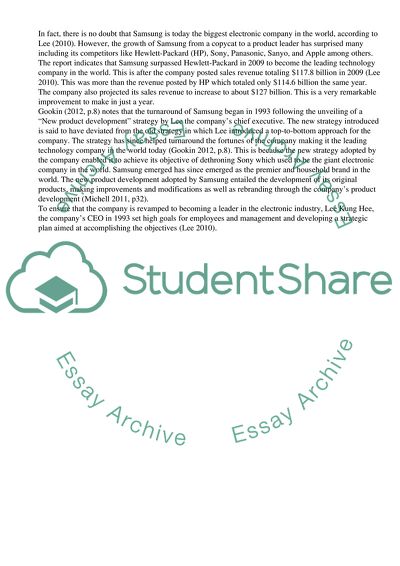Cite this document
(The Development of Samsung Group Assignment Example | Topics and Well Written Essays - 2250 words, n.d.)
The Development of Samsung Group Assignment Example | Topics and Well Written Essays - 2250 words. https://studentshare.org/business/1801191-1to-what-extent-do-you-think-samsung-has-moved-from-copycat-brand-to-product-leader-and-how-was-samsung-able-to-make-this-change-25-marks-2explain-the-importance-of-concepts-such-as-customer-centered-team-based-and-systematic-efforts-in-successfu
The Development of Samsung Group Assignment Example | Topics and Well Written Essays - 2250 words. https://studentshare.org/business/1801191-1to-what-extent-do-you-think-samsung-has-moved-from-copycat-brand-to-product-leader-and-how-was-samsung-able-to-make-this-change-25-marks-2explain-the-importance-of-concepts-such-as-customer-centered-team-based-and-systematic-efforts-in-successfu
(The Development of Samsung Group Assignment Example | Topics and Well Written Essays - 2250 Words)
The Development of Samsung Group Assignment Example | Topics and Well Written Essays - 2250 Words. https://studentshare.org/business/1801191-1to-what-extent-do-you-think-samsung-has-moved-from-copycat-brand-to-product-leader-and-how-was-samsung-able-to-make-this-change-25-marks-2explain-the-importance-of-concepts-such-as-customer-centered-team-based-and-systematic-efforts-in-successfu.
The Development of Samsung Group Assignment Example | Topics and Well Written Essays - 2250 Words. https://studentshare.org/business/1801191-1to-what-extent-do-you-think-samsung-has-moved-from-copycat-brand-to-product-leader-and-how-was-samsung-able-to-make-this-change-25-marks-2explain-the-importance-of-concepts-such-as-customer-centered-team-based-and-systematic-efforts-in-successfu.
“The Development of Samsung Group Assignment Example | Topics and Well Written Essays - 2250 Words”. https://studentshare.org/business/1801191-1to-what-extent-do-you-think-samsung-has-moved-from-copycat-brand-to-product-leader-and-how-was-samsung-able-to-make-this-change-25-marks-2explain-the-importance-of-concepts-such-as-customer-centered-team-based-and-systematic-efforts-in-successfu.


